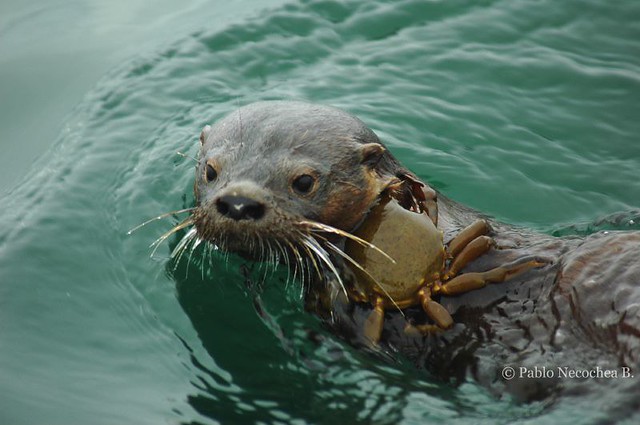Lontra felina Cladus: Eukaryota Name Lontra felina (Molina, 1782) Type locality: "Chili" [Chile]. Synonyms * Lutra brachydactyla Wagner, 1841
* Molina, J. I. 1782. Saggio sulla storia naturale del Chili, del signor abate Giovanni Ignazio Molina. Stemperoa del S. Tomaso d'Aquino, Bologna, 367 pp. (not seen, cited in Nowak, 1991)
Marine otters (Lontra felina) are rare and poorly-known marine mammals of the weasel family (Family Mustelidae). They are the most exclusively marine species of the otters of South America, and rarely even venture into freshwater or estuarine habitats. The scientific name means "otter cat," and in Spanish, marine otters are often referred to as gato marino—marine cat. In Chile the common name for the animal is chungungo.
Marine otters are found in littoral areas of southwestern South America. They are found close to shore and in the intertidal areas of southern Peru, the entire coast of Chile, and the extreme southern reaches of Argentina.[1] Occasional vagrant sightings still occur as far afield as the Falkland Islands. Physical description Marine otters are relatively small and among otters, only the oriental small-clawed otter is more diminutive. Length ranges from 83 to 113 cm (33-45 in) long, not counting a tail of 30-36 cm (12-14 in). Weight can range from 3 to 5.8 kg (6.6-13 lbs).[2] The fur of marine otters is dark brown on the dorsal surface (back) and light brown on the ventral surface (belly). The guard hairs cover short insulating fur with a grayish tone. The fur is coarser and tougher than in sea otters. Many think their fur is tougher than other otters because they live frequently in the surf where they can be pitched against the rocks. The front and hind-paws are webbed, and the tail short. The marine otter's lower jaws contain eight pairs of teeth, the upper jaws eight or nine pairs. The teeth are more developed for slicing than crushing. There is no sexual dimorphism in this species, and the females have four teats. Habitat and diet The otters mainly inhabit rocky shorelines with abundant seaweed and kelp, and infrequently visit estuaries and freshwater rivers. They appear to select habitats with surprising exposure to strong swells and winds, unlike many other otters, which prefer calmer waters. Caves and crevices in the rocky shorelines may provide them with the cover they need, and often a den will have no land access at high tide. Marine otters avoid sandy beaches. Little is known about the diet of marine otters, but their primary prey is believed to be crabs, shrimps, mollusks, and fish. Behavior and reproduction Marine otters are most often seen individually or in small groups of up to three. They are difficult to spot, swimming low in the water, exposing only their heads and backs. It is not known whether they are territorial or not, as males are occasionally seen fighting, yet fights have also been observed even between mating pairs. Fighting takes place on prominent rocks above the water line used for resting, feeding, and grooming. Marine otters have also been observed cooperatively feeding on large fish, but it is not known how common the practice is. The otters are diurnal mammals, primarily active in the daytime. Marine otters may be monogamous or polygamous, and breeding occurs in December or January. Litters of two to five pups each are born after a gestation period of 60 to 70 days, in January, February, or March. The pups remain with their mother for about 10 months of parental care, and can sometimes be seen on the mother's belly as she swims on her back, a practice similar to that of sea otters. Parents bring food to the pups and teach them to hunt. Conservation status Marine otters are rare and protected under Peruvian, Chilean, and Argentine law. In the past, marine otters were extensively hunted both for their fur and due to perceived competition with fisheries. Hunting extirpated the marine otter from most of Argentina and the Falkland Islands. Poaching is still a problem, but one of unknown magnitude. It is unknown how many marine otters exist in the wild or what habitats should be preserved to encourage their recovery. Marine otters were listed under CITES Appendix I in 1976, and are listed as endangered by the U.S. Department of the Interior. References ^ a b Alvarez, R. & Medina-Vogel, G. (2008). Lontra felina. In: IUCN 2008. IUCN Red List of Threatened Species. Downloaded on 02 January 2009. Wikispecies has information related to: Lontra felina Reeves, R. R., Stewart, B. S., Clapham, P. J., and J. A. Powell. 2002. National Audubon Society Guide to Marine Mammals of the World. Alfred A. Knopf. p. 47-48. Source: Wikispecies: All text is available under the terms of the GNU Free Documentation License |
|


